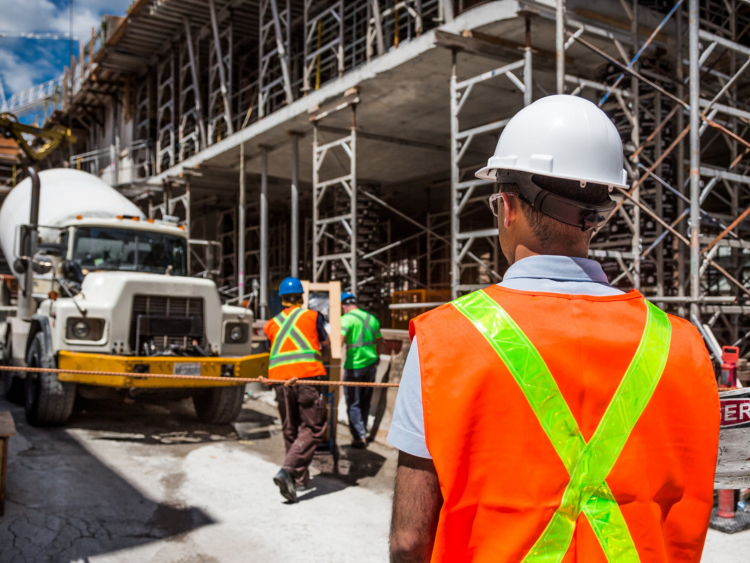Building & Construction

October 13, 2025
Tracking construction, Part 2: Building out the indicators
Written by Nicholas Bell
With U.S. aluminum extrusion consumption expected to approach 2 million metric tons this year, according to CRU data, it’s important to examine trends in the construction industry – particularly non-residential construction, given its significant role in aluminum extrusion demand for windows, curtain wall systems, and cladding applications.
We’re revisiting the construction backlog data analyzed earlier and building on it here to synthesize insights from multiple non-governmental datasets, providing a clearer picture of construction activity in the absence of updated federal statistics.
Total U.S. construction starts rose 1.7% in August to a seasonally adjusted annual rate of $1.23 trillion, according to Dodge Construction Network.
Year to date through August, total starts were 1.9% higher than the same period in 2024.
Non-residential starts increased 3.4%, residential starts declined 5.0%, and non-building starts rose 8.1%.
Over the 12 months ending August 2025, total construction starts were up by 4.7% from the previous year, driven by 12.1% growth in nonbuilding activity, while residential gained 1.2% and non-residential 4.8%.
Regional performance in August was uneven. Month-over-month construction starts rose sharply in the South Central U.S. (+53%) but declined elsewhere: Northeast (-25%), Midwest (-10%), South Atlantic (-2%), and West (-12%).
Nonbuilding activity
Nonbuilding starts grew 9.3% in August to a rate of $431 billion, led by strong utility and environmental projects.
The growth in nonbuilding starts was driven by a 39.7% surge in utilities, offsetting declines in highway and bridge work (-5.6%) and public works (-2.8%).
The largest nonbuilding August projects:
- $5.1 billion – Woodside LNG facility in Sulphur, La.
- $2.9 billion – Cheniere LNG facility in Corpus Christi, Texas.
- $1.8 billion – Kingston Energy Complex and Battery Storage in Kingston, Tenn.
Nonresidential construction activity
Nonresidential building starts declined 5.4% in August to an annual rate of $431 billion.
Commercial projects fell 12.0%, with retail down 11.3% and warehouse starts down 25.3%.
Institutional construction increased 3.7%, supported by gains in “other” institutional categories (9.9%), while healthcare (+2.8%) and education (+0.5%) logged modest gains.
Manufacturing activity was volatile, dropping 24.4% after a sharp gain in July.
The largest nonresidential August projects:
- $880 million – Geisinger Medical Center Tower in Danville, Pa.
- $666 million – Fort Meade East Campus Office Building in Fort Meade, Md.
- $540 million – UM Shore Medical Center in Easton, Md.
Residential construction activity
Residential starts increased 2.4% in August to an annual rate of $364 billion.
Single-family construction slipped 5.4%, while multifamily activity advanced 15.5%.
Year-to-date, total residential starts were down 5.0%, with single-family down 11.7% and multifamily up 9.9%.
The largest residential August projects:
- $619 million – Kuilei Place Mixed-Use Residential Tower in Honolulu.
- $413 million – 120 Brickell Residences in Miami.
- $383 million – Coles Street Mixed-Use Development in Jersey City, N.J.
Dodge Momentum Index (DMI)
The Dodge Momentum Index (DMI) rose 3.4% in September to 304.6 (2000=100), up from August’s revised 294.7.
The increase was driven by a 4.7% gain in commercial planning and a 0.9% rise in institutional planning.
Year to date, the index is up 33% from 2024, signaling continued momentum in early-stage project development.
Commercial planning was strongest in data centers and retail, offsetting weakness in warehouses, offices, and hotels.
Institutional growth was supported by education, healthcare, and public buildings, with the institutional component up 60% year over year.
The commercial segment grew 53% year over year, or 44% when excluding data centers.
Fifty-eight projects valued at $100 million or more entered planning in September:
For commercial projects
- $440 million – CyrusOne Data Center Campus in Yorkville, Ill.
- $384 million – Meta Data Center in Montgomery, Ala.
- $300 million – Gemini Data Center in Brandon, S.D.
For institutional projects
- $246 million – Philip Anthony Senior High School in Princeton, Texas.
- $227 million – HCA Medical City Healthcare Hospital in Prosper, Texas.
- $158 million – East Stamford Elementary/Middle School in Stamford, Texas.
If the leading correlation holds, the September DMI suggests nonresidential construction spending will strengthen into mid-2026 and early 2027, led by data infrastructure.
Architecture Billings Index (ABI)
The American Institute of Architects (AIA) and Deltek Architecture Billings Index registered a reading of 47.2 in August, marking the 18th consecutive month of declining billings the longest stretch of weakness since the index began 15 years ago.
Inquiries into new projects were essentially flat, while new design contracts declined, indicating continued hesitation to commit to projects.
Regionally, firms in the South reported the most stable conditions, while the West recorded its weakest results in nearly two years.
By industry, commercial/industrial firms saw the first uptick in billings in more than a year, while multifamily firms were flat and institutional firms softened further.
The ABI report also included a survey on mergers and acquisitions (M&A): 72% of firms haven’t pursued or considered M&A in the past year, though about two-thirds expect such activity to increased over the next 3-5 years, particularly among firms acquiring other architectural firms.
Framing the indicators
Infrastructure and public-heavy work construction remains strong across both the Dodge Construction Network data and the Associated Builders and Contractors’ Construction Backlog Indicator (CBI) figures.
ABC shows infrastructure backlog at roughly 11 months, and Dodge’s reported similarly robust nonbuilding starts in August.
At first glance, the “first uptick in billings in more than a year” for commercial/industrial architecture firms, noted in the ABI report, might be expected to align directly with ABC’s sharp rise in heavy industrial backlog, which more than doubled month to month in August. However, that surge in backlog likely reflects contracts advancing to execution, rather than a sudden increase in design billings.
Regional data also shows clear alignment.
ABC’s South region is the standout in lengthy backlog figures and posted a month-to-month increase, while the West region was the weakest and dropped dramatically on a sequential basis.
Dodge’s regional data for August tell a similar story. South Central-region starts were up sharply (+53%), while the West logged negative starts month over month. ABI mirrored this pattern exhibiting relative stability in the South and sustained weakness in the West.
Not all datasets aligned, some diverged.
ABC’s heavy industrial backlog, which more than doubled in August from the previous month, trends against Dodge’s August manufacturing starts, which simultaneously dropped sharply.
It should be noted that these two data series measure different aspects.
CBI captures work already under contract, while Dodge’s “starts” data tracks projects that have already broken physical ground. The lag between the two is particularly pronounced for large-scale industrial developments.
That said, the magnitude of ABC’s August increase, to 11.0 months in August from 5.1 months in July, suggests a likely one-off surge in reported workload, possibly tied to a small number of major industrial contract awards. Such a jump makes direct month-to-month comparison difficult, but it does not necessarily contradict Dodge’s figures: it may just precede them in the pipeline’s timeline.
A smaller but still notable divergence appears in the commercial/institutional segments. ABC’s CBI for these sectors softened in August, while the Dodge Momentum Index – a leading indicator (i.e. not real-time “starts”) – rose again in September and is up significantly year-to-date. The difference may reflect the timing gap between the two as ABC’s CBI measures work already under contract, while the DMI measures projects only entering the planning phase.
In other words, ABC is signaling fewer months of booked work right now, while DMI is signaling that the pipeline for future bookings is filling.
There’s also distinction in scope. The CBI, ABI, and DMI are all leading indicators that anticipate future construction activity, Dodge’s construction starts data is a real-time measure of work that has already broken ground. Juxtaposing these datasets alongside Census Bureau spending data would offer a fuller picture of how design and planning trends are translating into actual construction activity.
This article is Part Two of a two-part series on U.S. construction trends. Be sure you didn’t miss Part One, where we analyzed the latest Construction Backlog Indicator data.







